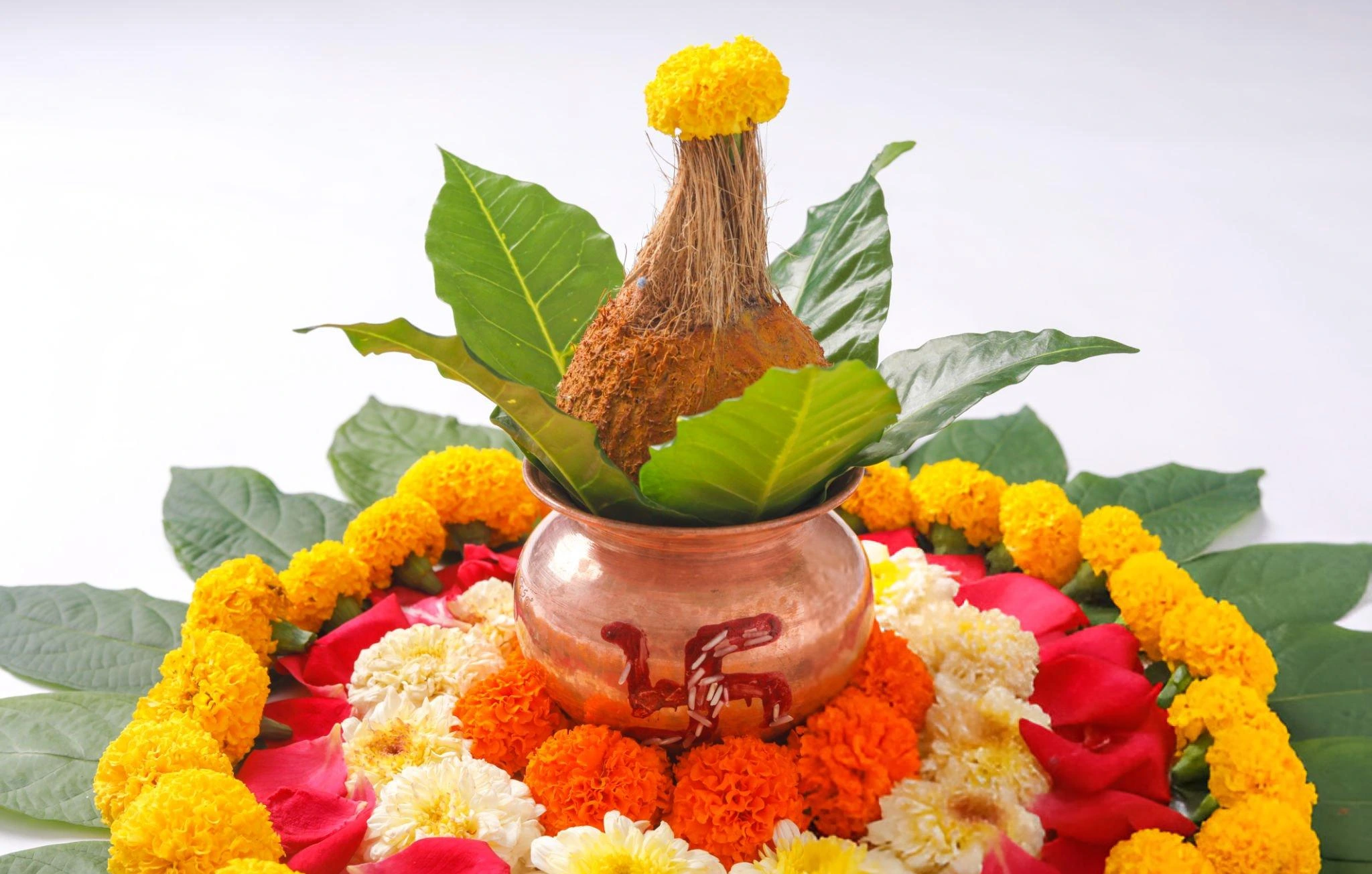Table of Contents
Introduction: The Sacred Ritual of Kalash Sthapana in Navratri
Navratri is one of the most auspicious Hindu festivals celebrated over nine nights, dedicated to the worship of Goddess Durga in her various forms. A significant ritual that marks the beginning of this festival is the Kalash Sthapana (Ghatasthapana), a sacred process where a Kalash, or a pot filled with holy water, is installed to invoke the goddess’s divine presence.
But as Navratri concludes, a crucial question arises: How and when should we remove the Kalash after Navratri? What should we do with them after the ritual is over? The process of removing the Kalash is as spiritually significant as its installation. It must be done with the same devotion and precision, following the correct steps to ensure that the goddess’s blessings continue to protect your household.
In this blog, we will dive deep into the step-by-step guide for removing the Kalash and provide detailed information on what should be done with the items, ensuring the ritual concludes properly and respectfully.
What Is Kalasha Sthapana?
Before we get into the specifics of removal, let’s understand what Kalasha Sthapana is and why it is performed.
Kalash Sthapana is a powerful Vedic ritual that symbolizes the divine presence of Goddess Durga in your home during Navratri. It is one of the first steps taken during the festival, generally performed on the first day of Navratri, known as Pratipada. The Kalash, which is a pot filled with sacred water, is decorated with mango leaves, a coconut, and red cloth. It is placed on a bed of rice and worshipped as a representation of the goddess herself.
Purpose of Kalasha Sthapana:
- It represents the goddess or deity you are worshipping, and the Kalash serves as a medium to invoke their blessings.
- The Kalash symbolizes life and creation, with the water inside representing the cosmic energy of the universe.
- The coconut represents the head of the deity, while the mango leaves represent nature and fertility.
How to Remove the Kalash After Navratri: A Step-by-Step Guide
The removal of the Kalash is a spiritual process that must be done with care and devotion. It is more than just physically moving the Kalash—it symbolizes bidding farewell to the goddess and thanking her for the blessings bestowed upon your family during Navratri.
Here is a step-by-step guide on how to properly remove the Kalash after Navratri:
Step 1: Perform the Final Aarti
Before you remove the Kalash, it is important to perform the final aarti and offer prayers to Goddess Durga. This is done to thank her for visiting your home and bestowing her blessings.
- Prepare for the Aarti: Light a lamp or diya, burn incense sticks, and offer flowers and sweets to the Kalash.
- Chant Mantras: Recite the Durga Chalisa, Durga Saptashati, or any other relevant hymns to conclude the Navratri prayers.
- Express Gratitude: While performing the aarti, express your gratitude to the goddess and seek her blessings for continued peace, prosperity, and health.
Step 2: Shake the Kalash Five Times
It is often believed that before lifting the Kalash, you should shake it gently five times. This is a symbolic way of respectfully disengaging the divine energy invoked through the Kalash during Navratri. The five shakes represent the five elements—earth, water, fire, air, and ether—through which the energy disperses evenly.
Step 3: Remove the Kalash with Devotion
After the final aarti and shaking the Kalash, gently lift it from its place with both hands. Hold it carefully, and while lifting it, mentally offer your final prayers to the goddess. This signifies the conclusion of the goddess’s stay in your home during Navratri.
Step 4: Dispose of the Kalash Water
The water inside the Kalash is sacred, as it holds the divine energy of the goddess. You should not simply discard it. Instead, here’s what you can do:
- Sprinkle It Around the House: Many devotees sprinkle the water around the house to purify the home and spread the goddess’s blessings to every corner.
- Pour It into a Plant: You can also pour the water into a plant, symbolizing the return of divine energy to nature.
- Immersion: In some traditions, devotees immerse the water in a river or pond as part of the Kalash Visarjan ritual.
Step 5: Offer the Coconut and Mango Leaves
The coconut and mango leaves used in the Kalash are also considered sacred. Here’s how to handle them:
- Coconut: You can break the coconut and offer it as prasad to family members or neighbors. Some devotees choose to offer the coconut in a temple.
- Mango Leaves: The mango leaves can be added to a compost pile or immersed in water, returning them to nature with respect.
Step 6: Cleanse the Area
After removing the Kalash and its items, it’s important to cleanse the area where the Kalash was placed. Sprinkle holy water (Ganga Jal) and clean the space to purify it. You can also light incense or offer prayers to maintain the sacredness of the area.
When Should You Remove the Kalash After Navratri?
The timing of removing the Kalash after Navratri is important to ensure the ritual’s spiritual efficacy. The most common day for removing the Kalash is on Vijayadashami, also known as Dussehra, which marks the 10th day after Navratri.
Best Time to Remove the Kalash
- Vijayadashami Day: This day is considered the most auspicious for Kalash removal, as it marks the triumph of good over evil. It is the day when Goddess Durga is believed to return to her celestial abode after visiting the earth.
- Morning or Evening: Many devotees prefer to remove the Kalash either early in the morning or during the evening aarti time. The final prayers and offerings are made during these periods before the Kalash is removed.
Exceptions to Timing
- In some regions or family traditions, the Kalash may be removed on the 9th day of Navratri, also known as Maha Navami.
- Devotees who observe a different set of customs may choose to remove the Kalash after completing their fast on the 9th day, especially if they conclude their celebrations earlier.
Always follow your family’s traditions or consult a priest to determine the ideal time for your household.
What to Do with the Kalash Items After Navratri?
Once the Kalash has been removed, devotees often wonder what should be done with the sacred items used during the ritual, such as the coconut, mango leaves, and holy water. Here is how to handle these items respectfully:
1. The Coconut
The coconut placed atop the Kalash is considered highly sacred and symbolizes the presence of the goddess.
- Prasad: Break the coconut and offer it as prasad to family members, friends, or neighbors. Consuming the coconut as prasad ensures that the blessings of the goddess continue to spread.
- Temple Offering: You can also choose to offer the coconut at a nearby temple if that aligns with your family’s traditions.
- Use in Cooking: Some devotees use the coconut in the preparation of sweets or other dishes, such as coconut laddoos, to ensure that the divine energy stays within the home.
2. Mango Leaves
Mango leaves, which are placed around the mouth of the Kalash, represent prosperity and fertility. They should also be handled with care.
- Compost: The mango leaves can be returned to nature by composting them, ensuring that the energy from the ritual nourishes the earth.
- Immersion: You can also immerse the leaves in a natural water body, such as a river or pond, which is a traditional practice in some regions.
3. Holy Water (Ganga Jal or Sacred Water)
The water inside the Kalash is infused with divine energy and should never be discarded carelessly.
- Sprinkling Around the House: Sprinkle the water in all rooms of your home to purify and bless your living space.
- Watering Plants: Pour the water into plants or a garden, returning the divine energy to nature.
- Immersion in a River or Pond: In some traditions, devotees immerse the holy water in a flowing water body like a river, signifying the return of the goddess to the earth.
4. The Kalash (Pot) Itself
The pot used in the Kalash Sthapana can either be stored for future use or immersed along with the holy water, depending on your tradition.
- Reuse the Kalash: If the Kalash is made of metal like copper or brass, clean it thoroughly and store it for future religious rituals.
- Immersion: In some families, the Kalash is immersed in a river, particularly if it is made of clay or a biodegradable material.
The Spiritual Energy Behind Kalash Removal: Why It Matters
The process of removing the Kalash is deeply rooted in spiritual symbolism and is just as important as its installation. By following the proper steps for removal, you ensure that the goddess’s blessings continue to protect your household long after Navratri is over. Let’s explore the spiritual reasons behind why Kalash removal is so significant:
1. Symbolizing the Departure of the Goddess
The Kalash is not merely a pot—it embodies the divine energy of Goddess Durga. Removing the Kalash after Navratri symbolizes the goddess’s return to her celestial abode. Doing this ritual with care and devotion ensures that the goddess departs with positive energy and leaves behind her blessings.
2. Maintaining the Balance of Energy
By removing the Kalash in the correct manner, you maintain the spiritual balance in your home. The act of sprinkling the holy water and distributing the prasad ensures that the divine energy spreads throughout your household, leaving no corner untouched by blessings.
3. Completing the Circle of Rituals
Every ritual in Hinduism is part of a spiritual cycle, and Navratri is no exception. The process begins with Kalash Sthapana and ends with its removal. If the Kalash is not removed properly, the ritual remains incomplete, potentially affecting the flow of blessings into your life.
Common Mistakes to Avoid When Removing the Kalasha
Removing the Kalasha is a crucial part of concluding your religious ceremony, and certain mistakes could affect the sanctity of the ritual. Here are some common mistakes to avoid:
1. Skipping the Final Aarti
Some devotees might overlook the importance of performing the final aarti before removing the Kalash. This step is crucial because it serves as a formal farewell to the goddess, thanking her for her blessings during Navratri.
2. Disposing of Items Carelessly
The sacred items used in Kalasha Sthapana, like the coconut and mango leaves, should not be thrown away carelessly. Always handle them with reverence and dispose of them in an eco-friendly or religiously appropriate manner.
3. Delaying the Removal
It’s important not to delay removing the Kalash after the festival or ritual is over. Leaving it in place too long can disrupt the flow of divine energy and is considered inauspicious in some traditions.
4. Not Cleansing the Area After Removal
After removing the Kalash, failing to cleanse the area where it was placed is another common mistake. The space should be purified with holy water and maintained as a sacred spot, even after the Kalash has been removed.
5. Ignoring Family or Regional Traditions
Many families and regions have specific customs when it comes to removing the Kalash. Ignoring these traditions may unintentionally disrespect the ritual. It’s always best to follow your family’s traditions or seek guidance from a priest if you are unsure about the exact procedure.
Frequently Asked Questions (FAQs) About Kalash Removal After Navratri
Q: Can I remove the Kalash on a day other than Vijayadashami?
A: While Vijayadashami is the most auspicious day for removing the Kalash, some families or regions may follow traditions that allow for its removal on Maha Navami (the 9th day of Navratri). Always follow the traditions of your family or consult a priest if you are unsure.
Q: What should I do if the Kalash falls or breaks during Navratri?
A: If the Kalash falls or breaks during the festival, immediately offer prayers to the goddess, asking for forgiveness and protection. Replace the broken Kalash with a new one, and continue the ritual from where it was interrupted.
Q: Is it mandatory to immerse the Kalash in a river after Navratri?
A: Immersing the Kalash in a river is a common tradition, but it is not mandatory in all households. Some families prefer to sprinkle the holy water around their home or pour it into plants. The key is to handle the Kalash and its contents with respect.
Q: Can I reuse the Kalash for future rituals?
A: Yes, if the Kalash is made of metal like brass or copper, you can clean and store it for future rituals. However, if the Kalash is made of clay, it is typically immersed or discarded respectfully after the festival.
Q: Can I remove the Kalash if I missed performing the final aarti?
A: It is always recommended to perform the final aarti before removing the Kalash, but if you missed it, offer prayers to the goddess and proceed with the removal. The intention behind the ritual is what matters most.
Conclusion: Completing the Circle of Devotion
Removing the Kalash after Navratri is a deeply spiritual and significant ritual that marks the end of your Navratri celebrations. By following the correct process and timing, you ensure that the divine energy of Goddess Durga continues to bless your household throughout the year. Whether you’re removing the Kalash on Vijayadashami or another auspicious day, doing so with care and devotion completes the spiritual circle of Navratri.
By taking these steps, you preserve the sanctity of the festival and invite continued blessings of prosperity, protection, and peace into your home. May your devotion to Goddess Durga bring you and your family immense joy and success in all your endeavors.




